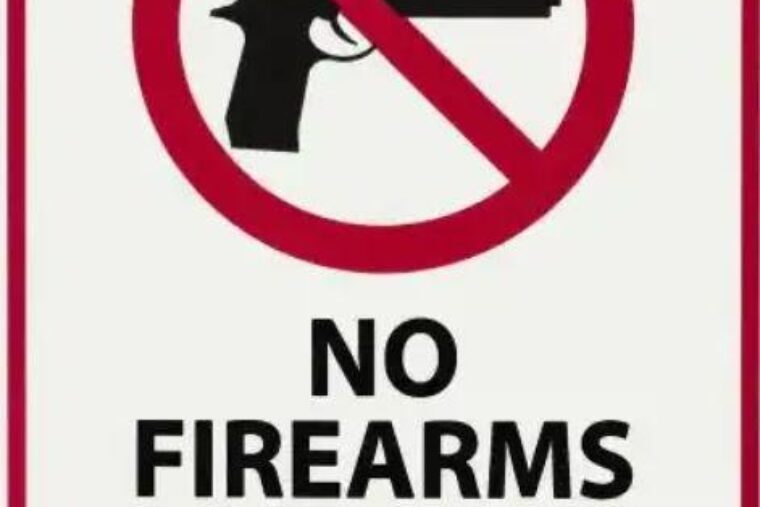Guest post by William “Bill” Waddell.
Disclaimer: I am not a lawyer. I have no formal legal training, and I am not licensed to practice law in Arizona or in any other state. Any statement or assertion I make in this post represents my own understanding of the law from a layman’s perspective. Nothing in this post should be construed as legal advice.
On 22 July of this year, a man entered the Greenwood Park Mall in Indiana armed with two rifles and a pistol, with the obvious intent to commit mass murder. In doing so, he ignored the “No Guns” signs posted at the mall entrances, and violated the mall’s policy prohibiting firearms on the property. He opened fire on innocent mall patrons, killing three and injuring two others.
The death toll could have been far, far worse. A mere fifteen seconds after the perpetrator opened fire, a 22-year-old man named Elisjsha “Eli” Dicken drew his concealed pistol and engaged the shooter, fatally wounding him and ending his murderous shooting spree. Fortunately, we will never know how many lives were saved by Mr. Dicken’s heroic action, but it is almost certain that many more people would have been gravely wounded and killed had Mr. Dicken not been armed.
In carrying his concealed pistol into the Greenwood Park Mall, Mr. Dicken, like the perpetrator, also violated the mall’s prohibition on firearms. Fortunately, in Indiana, “No Guns” signs on private property do not carry the force of law. If mall security had realized that Mr. Dicken was carrying a firearm against mall policy, they could only have asked him to leave. If he had refused, he could have been charged with criminal trespass. If he had immediately complied, no charges could have been filed against him. This is the case in most states.
In other states, signs on private property prohibiting the carry of firearms do have the force of law. Unfortunately, Arizona is one such state.
Arizona Revised Statutes (ARS) § 13-1502 (A) (1) states: “A person commits criminal trespass in the third degree by…knowingly entering or remaining unlawfully on any real property after a reasonable request to leave by a law enforcement officer, the owner or any other person having lawful control over such property, or reasonable notice prohibiting entry” (emphasis added). It is well established in case law that a sign constitutes reasonable notice. The use of the conjunctive “or” means that a sign is sufficient by itself and does not need to be reinforced by a verbal request. Any sign which a reasonable person would believe is intended to prohibit firearms on the property is considered reasonable notice under this statute; there is no requirement that the sign be of a particular size, include any particular graphic, use any particular wording, or reference the applicable statute.
Criminal trespass in the third degree is a Class 3 misdemeanor, with a penalty of up to 30 days in jail, a fine of up to $500, or both. With surcharges and assessments, the actual fine may be nearly $1,000 for a first offense. The penalty increases drastically for subsequent offenses.
ARS § 13-1502 is not the only section of the Arizona Revised Statutes which addresses the carry of a firearm. There are two other statutes: ARS § 13-3102 dealing with carry into places owned, leased, or operated by the state or a political subdivision; and ARS § 4-229 dealing with carry into establishments licensed to dispense alcoholic beverages for on-premises consumption (bars and many restaurants). Only the latter stipulates what form a notice must take: it must be posted in a conspicuous location accessible to the general public and immediately adjacent to the liquor license; it must contain a pictogram that shows a firearm within a red circle and a diagonal red line across the firearm; and it must contain the words, “no firearms allowed pursuant to A.R.S. section 4-229”. For any establishment not covered under ARS § 4-229, which is any establishment except a bar or restaurant that serves alcohol, there is no stipulation on what form their sign must take.
If the Greenwood Park Mall shooting had occurred in Arizona instead of in Indiana, Mr. Dicken would been guilty of a Class 3 Misdemeanor, and he could have been charged. If convicted, he could have received a fine and been jailed. It is highly doubtful that any prosecutor would have filed such charges, given the public outcry which would have ensued and the likelihood of any jury returning a guilty verdict, but those charges could have been filed. Worse still, if Mr. Dicken was in Arizona and was aware of the potential penalty for ignoring the mall’s “No Guns” sign, he may have chosen to enter unarmed, and many more innocent lives may have been lost.
I think it is time that we look closely at amending ARS § 13-1502 (A) (1) by removing the last clause, “…or reasonable notice prohibiting entry”. I respect property rights, but they must be balanced against other rights including those enshrined in the Second Amendment of the United States Constitution and in Article 2, Section 26 of the Arizona Constitution. The great state of Arizona should not criminalize the act of ignoring a sign posted by a private party. If a property owner wishes to exclude a customer who is lawfully carrying a defensive firearm, the owner, or an employee or other representative, should ask that customer to leave. Customers who are carrying discretely will not attract the attention which would trigger such a request, which is another incentive to carry concealed. This is how most states handle the balance between property rights and Second Amendment rights, and Arizona should update our laws to restore that balance.
This does not constitute, nor should be implied as, legal advice. Always seek an attorney’s advice and consult state and local laws yourself. User assumes all liability for use of the information provided here.
Mr. William “Bill” Waddell is a retired Department of Defense intelligence analyst with more than thirty-five years of experience. During his career, he deployed to Iraq and Afghanistan to provide intelligence support to counterterrorism combat operations by elite US and Coalition forces. Bill is an alumnus of some of the world’s most prestigious firearms training programs, and is a firearms instructor.



